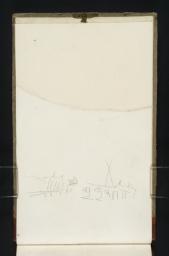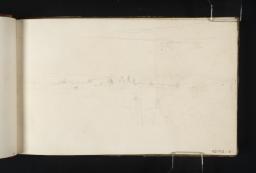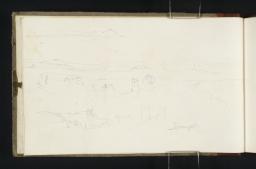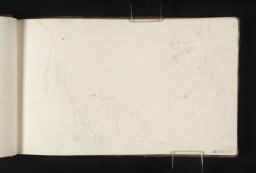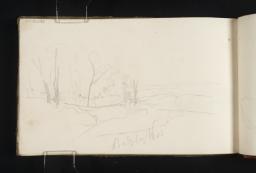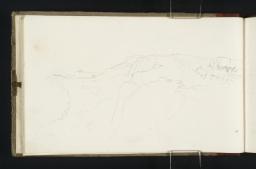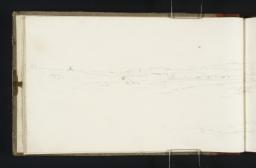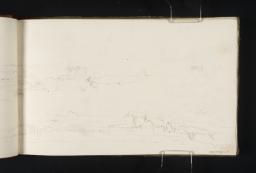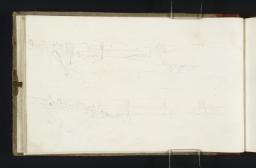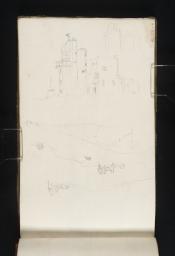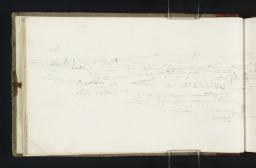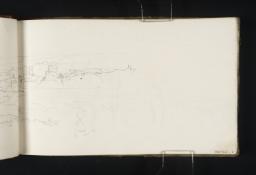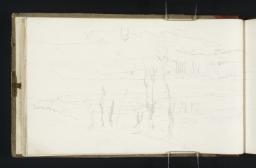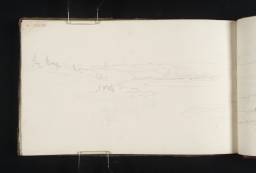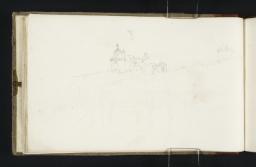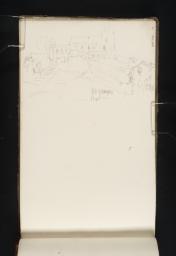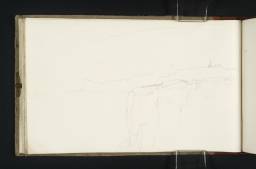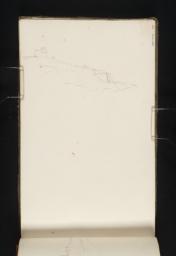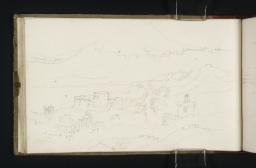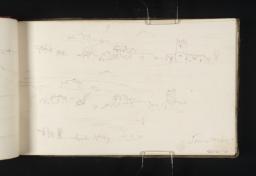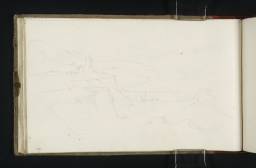Turner Bequest CXCVIII 1–91a
Sketchbook, bound in boards, covered in grey paper quarter-bound over brown leather spine; one brass clasp, now missing; page edges washed in yellow
91 leaves and paste-downs of white wove paper; page size 113 x 187 mm
Made by Thomas Edmonds of Rye Mill, Wycombe, Buckinghamshire; various leaves watermarked ‘T Edmonds | 1819’
Numbered 353 as part of the Turner Schedule in 1854 and endorsed by the Executors of the Turner Bequest, inside back cover (D40686)
Stamped in black ‘CXCVIII’ on front cover, top right
91 leaves and paste-downs of white wove paper; page size 113 x 187 mm
Made by Thomas Edmonds of Rye Mill, Wycombe, Buckinghamshire; various leaves watermarked ‘T Edmonds | 1819’
Numbered 353 as part of the Turner Schedule in 1854 and endorsed by the Executors of the Turner Bequest, inside back cover (D40686)
Stamped in black ‘CXCVIII’ on front cover, top right
Accepted by the nation as part of the Turner Bequest 1856
References
As identified by Finberg, this small sketchbook is comprised largely of multiple views observed along the Kent coast, particularly densely recorded at points between Folkestone and Dover.1 The most unusual pages describe illustrations of coastal headlands taken from maritime text The Little Sea Torch, translated into English and published in London in 1801. Drawings made of various Kentish subjects recur throughout the sketchbook without obvious pattern, although perhaps a broad assessment would place Folkestone and Rochester studies closer to the beginning, with a move towards Dover and Sandgate charted in later pages.
Additionally, the sketchbook includes a smattering of sporadic studies made within sight of Oxford. Towards the beginning of the book, these are recorded on the inside front cover, and on folios 1 recto, 1 verso, 2 recto, 2 verso, 5 recto, and 17 recto (D40685, D17207–D17210, D17214, D17234). Later Oxford studies can be found amongst the closing pages on folios 87 verso and 88 recto (D17356–D17357).
Finberg thought that the sketchbook was in use around 1821. The incongruous sketches of Oxford listed above have lead scholars including Ian Warrell,2 David Blayney Brown,3 and James Hamilton,4 generally to agree that it was actively being added to in the early 1820s. They link the book’s use to a period immediately following the death of Turner’s uncle, J.M.W. Marshall, in June 1820.5 Marshall lived in Sunningwell, near Oxford, and seems to have nurtured a warm relationship with Turner.6 He owned property in Wapping and Barkingside which was divided between his nephews, J.M.W. Turner and Henry Harpur, on the event of his death.7 Evidence of tenant transactions for the properties is also in the present sketchbook. A receipt can be found on folio 91 verso (D17364). Marshall’s widow, Mary, was left an annuity, which Turner is thought to have administered personally. Hamilton writes that ‘[Turner] visited his aunt soon after her husband’s death, making sketches of Oxford and Sunningwell in the “Folkestone” sketchbook on the way’.8
The 1821 dating of the sketchbook is retained here but expanded slightly, to account for depictions of the Episcopal Chapel at Sandgate on folios 16 verso, 41 recto, 44 recto, 47 recto, 57 verso, and 91 recto (D17233, D17277, D17280, D17285, D17301, and D17363). This chapel was consecrated in May 1822. A broader dating also aligns with Warrell’s suggestion that ‘Turner began to use this book in 1821 and probably continued filling up blank pages the following year’.9
Warrell has also observed that ‘there are notes of a sea voyage down the English coast from the Solent to Cornwall in the Folkestone sketchbook’.10 Other scholars, including Finberg, were also in agreement, suggesting that Turner may have undertaken a trip in order to sketch a long, geographically diverse run of headland prospects: ‘the book contains views of the French coast drawn from the sea and others of the English coast as far west as Start Point and the Bolt Head’.11 There are two blocks of pages which deal with these subjects. The first group can be found between folios 55 recto and 57 recto (D17296–D17300). The second is slightly more spread out at a later point in the sketchbook, on folios 77 verso, 78 verso, 79 recto, and 80 verso (D17338, D17340–D17341, and D17344).
Rather than supplying evidence of a tour, the views on the sheets listed above are taken from The Little Sea Torch, a maritime text by Richard Bougard first published in 1684. It was translated from the French by John Thomas Serres, who also contributed illustrations, and was published in London in 1801 by J. Debrett of Piccadilly, printed by T. Rickaby, at Peterborough-Court, Fleet-Street.12 The coloured views of headlands, ports, lighthouses, and harbours are therefore unique to the English edition.13 Around 1800, Turner shared a studio with Serres at 64 Harley Street in London (see Turner’s ‘Biography’ in the present catalogue). This lends a personal dimension to the bout of emulative sketching.
Assessing The Little Sea Torch in 1801, a reviewer writing for the British Critic opened his otherwise overwhelmingly positive commentary with the feeling that the title seemed ‘quaint, and, to an Englishman, almost ridiculous’.14 The title page is a preposterously detailed document. It describes in depth what a subscriber could expect to find inside and displays quite clearly the appeal that the volume might have held for Turner:
The | Little Sea Torch:| or, | True Guide for Coasting Pilots:| By Which | They Are Clearly Instructed How to Navigate Along the Coasts of | England, Ireland, France, Spain, Portugal, Italy, | and Sicily; | The Isles of | Malta, Corsica, Sardinia, and Others in the Straits; | and of | The Coast of Barbary, | From Cape Bon to Cape der Verd | Enriched | With Upwards of One Hundred Appearances of Head-Lands and Light-Houses. | Together with Plans of the Principle Harbours. | Also | A Table of Soundings, and Various Explanatory Remarks. | The Whole forming a Work of the greatest Utility to Seamen, and peculiarly calculated to instruct the curious Inquirer into | those Subjects that are connected with Maritime Geography.15
The meticulous nature of the promises outlined above concerning the content of the book coheres with Turner’s similarly studious approach to its illustrations. A long list of named subscribers is also included at the beginning of the printed volume, and describes a great number of alphabetised admirals, lieutenants, captains, and earls.16 The Little Sea Torch is effectively a book of lists elaborated to varying degrees. The drawings Turner made from it adhere to that format.
Turner’s copies were probably produced in one or two sessions with the book, as he leafed through the colour plates and swiftly noted down compositions which appealed to him, or with which he was already somewhat familiar. There seems to be little discernible method to his selections. In some instances he fills a page with illustrations taken from a single plate; in others the choices are more sporadic and unpredictable. Presumably he was seeking inspiration, or perhaps found himself simply without sufficient stimulation in an environment that proffered the opportunity to study a text extensively illustrated by an old acquaintance.
Elsewhere, there are sketches of Rochester (see folio 6 verso; D17217), and a sizable group of pages which describe Sandgate (see folio 16 verso; D17233). Drawings of Dover comprise a substantial section of this sketchbook and represent a frequently repeated theme in Turner’s oeuvre more generally. William S. Rodner17 and Ian Warrell18 have both remarked that Turner probably returned to these sketches in December 1822, when working on the watercolour Dover Castle from the Sea (Museum of Fine Arts, Boston).19 Certainly there are many studies in this book of Dover Castle, a full list of which can be found in the entry for folio 24 recto (D17247). Sketches of the surrounding topography are considered in the entry for folio 71 verso (D17329). Rodner expresses an additional theory that Turner encountered the Dover mail steamers Arrow and Dasher during this 1821 trip, which would thus have inspired the vessel pictured in the aforementioned finished work.20 However, there is no evidence to support this in the present sketchbook.
David Blayney Brown describes how the drawings of Dover in this sketchbook may have influenced the watercolour Dover, from Shakespeare Cliff of about 1824 (currently untraced),21 engraved by G. Cooke and published in 1826 for Southern Coast (Tate impressions: T04424, T05246–T05251, T06000).22Views such as those on folio 24 recto and 46 recto (D17247 and D17285) certainly demonstrate attention to the Castle in relation to the local topography and explore the perspective implications of the building’s elevated seat above the harbour. However, a view in the Holland sketchbook of 1825 (Tate D18843; Turner Bequest CCXIV 2) probably served more directly as inspiration.23 Brown also identifies a page in the Richmond Hill; Hastings to Margate sketchbook of around 1816–19 (Tate D10473; Turner Bequest CXL 33a) as material for the same watercolour in his catalogue entry for that page, illustrating the longevity with which the subject held Turner’s interest. Another finished rendering of the spot was the watercolour Straits of Dover produced in around 1827 (currently untraced)24 for the projected series of 120 Picturesque Views in England and Wales, commissioned by Charles Heath in 1825; it was engraved in 1828 (no Tate impression; see 1863 version: T06618).
Of course, there are numerous drawings of Folkestone to be found in the leaves of this sketchbook. A list of the folios which display these explicitly can be found in the entry for folio 17 verso (D17235). However, the whole book functions as an ode to the coastal topography around the area. Additional leaves spread throughout describe towering rock faces and craggy peninsulas which together elaborate on and flesh out a delicate and thorough portrait of place.
For additional sketchbooks in which Turner considers Folkestone see the Richmond Hill; Hastings to Margate sketchbook dating from around 1816–19 (Tate D10475–D10477, D10479; Turner Bequest CXL 34a, 35, 35a, 36a); the Holland sketchbook of 1825 (Tate D18855–D18864, D18866–D18879, D18883, D19399; Turner Bequest CCXIV 8–12a, 13a–20, 22a, CCXIV 282); the Holland, Meuse and Cologne sketchbook dating from about 1825 (Tate D19410; Turner Bequest CCXV 5a); the France and Folkestone sketchbook of 1826 (Tate D24107, D24109–D24135, D24138, D24167; Turner Bequest CCLVI 1, 2–14a, 15, 17v, 44a); the Folkestone (?) sketchbook of around 1845 (Tate; Turner Bequest CCCLXII); and the Near Folkestone (?) sketchbook of about 1845 (Tate; Turner Bequest CCCLIV).
For drawings and watercolours of Folkestone made in the early 1820s for the Ports of England series, see Tate D17760, D17761, and D25365 (Turner Bequest CCIII C, D, CCLXIII 243) and Tate D1815825 and D25480 (Turner Bequest CCVIII Y, CCLXIII 357). In collections elsewhere see Folkestone, Kent, 1823 (Taft Museum of Art, Cincinnati);26 Fishing Boats on Folkestone Beach, Kent, of about 1828 (The National Gallery of Ireland);27 and Folkestone Harbour and Coast to Dover from around 1829 (Yale Center for British Art, New Haven).28
For engravings after Turner which describe views of Folkestone, see Tate’s impression of Folkestone 1826, from the Picturesque Views on the Southern Coast of England series (Tate impression: T05254) and Folkestone 1830 (Tate impression: T05197), intended for the Marine Views series.29 Luke Herrmann notes that the latter may have been abandoned in light of a quarrel between Turner and the engraver Thomas Lupton.30
Richard Bougard, The Little Sea Torch: or, True Guide for Coasting Pilots: by which they are clearly instructed how to navigate along the coasts of Malta, Corsica, Sardinia, and others in the Straits; and of The Coast of Barbary, from Cape Bon to Cape de Verd, trans. with corrections and additions by John Thomas Serres, London 1801. For an online and PDF facsimile, see ‘The Little Sea Torch’, Biblioteca Nacional de Portugal, accessed 26 October 2015, http://purl.pt/23500 .
‘Lot 167’, 25 March 2015, Bonhams, accessed 25 November 2015, http://www.bonhams.com/auctions/22731/lot/167/ .
‘Serres’s Guide for Coasting Pilots’, The British Critic, for July, August, September, October, November, and December, M DCCCI, vol.XVIII, London 1801, p.532.
See an online scan of the title page to The Little Sea Torch, accessed 25 November 2015, http://purl.pt/23500/1/index.html#/11/html .
‘List of Subscribers to The Little Sea Torch’, The Little Sea Torch, p.[v], accessed 25 November 2015, http://purl.pt/23500/1/index.html#/15/html .
Technical notes
How to cite
Maud Whatley, ‘Folkestone Sketchbook c.1821–2’, sketchbook, January 2016, in David Blayney Brown (ed.), J.M.W. Turner: Sketchbooks, Drawings and Watercolours, Tate Research Publication, February 2017, https://www



